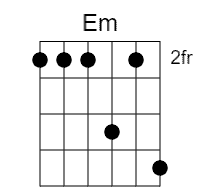DADGAD is a tuning that you hear about quite often on the internet. And in my opinion, it’s a pretty weird one.
Apparently, it was inspired by the sound of an oud instrument in Morocco. A common oud tuning is DGADGC.
And DADGAD tuning has a very Indian, upper African, and (Middle) Eastern sound to it like a sitar.
But when a British folk musician took the slightly altered tuning from Morocco back to the British Isles, it became commonly used for Celtic music, thus its other name: Celtic tuning
DADGAD can be a fun tuning to experiment with but trying to use it with traditional chord voicings requires some flexible fingers. So this is really a tuning that might lead you to explore genres you’re not used to and to see how other people have adapted it to rock and folk music.
Before you start imagining Leprechauns dancing to DADGAD songs, Celtic refers to the ethnicity and culture of people scattered throughout many regions of the United Kingdom.
And the use of chords while letting open strings act as drone strings is useful in creating sounds such as bagpipes make.
So while we will focus mostly on this tuning as it is used in popular “Western” music, it’s cool to know some of the history if anyone ever asks you.
Is DADGAD an open tuning?
DADGAD is not an open tuning because of that pesky G note. Open D is done by tuning to D-A-D-F#-A-D instead.
So DADGAD is actually a Dsus4 tuning. As a result, the chords used with this tuning get downright wacky.
How to tune your guitar in DADGAD?
If you don’t want to use a tuner or your mobile device, you can easily get to DADGAD from standard tuning.
Start by tuning your 6th string down until holding it at the 7th fret matches the open 5th string (A). Of course, if you have been playing guitar for a while you can probably just tune down your E string by ear until you hear Drop D tuning.
Then tune your 2nd string down a full step until it matches the 3rd string played at the 2nd fret (A).
Finally, tune your 6th string down a full step until it matches the 5th string played at the 5th fret (now a D note).
Then give the strings a quick re-check for fine-tuning and play each open D string to see if they sound like proper octaves. You should be ready to go.
DADGAD tuning chord shapes
Open chords
Strumming all of your guitar’s strings in this tuning gives you Dsus4. So holding all strings at the same fret or using a slide/capo will give you sus4 chords (whatever the bass note fretted on the sixth string is) anywhere on the fretboard.
Major chords
Now things get a bit trickier since old chord shapes don’t apply. Here is a breakdown of the major chord shapes.
I apologize in advance to your fingers.
A: x 0 2 2 4 2

B: x x x 4 6 4

C: x 3 2 0 3 2

D: 0 0 4 2 0 0

E: 2 2 2 4 2 6

F: 3 3 3 5 3 7

G: 5 2 0 0 5 0

Minor chords
A: x 0 2 2 3 2

B: x 2 4 4 2 0

C: x 3 1 0 3 1

D: 0 0 3 2 0 0

E: 2 2 2 4 2 5

F: 3 3 3 5 3 6

G: 5 5 0 0 1 0

Dominant chords
A: x02042

B: x21404

C: x32012

D: 004500

E: 220120

F: 301503

G: 553020

Sus2
(Remember that Sus4 chords are just the open tuning)
A: x02222

B: xxx444

C: x30030

D: 002200

E: 222424

F: 333535

G: xxx000

Extensions (add9)
A: x02442

B: xx98911

C: x32030

D: 090900

E: 226424

F: 333003

G: 520000

DADGAD tuning scales
For scales, let’s use D as our root note and explore a few different popular scales.
I recommend first learning them as D with the open strings and then moving up the fretboard to an E or A root note to practice learning the fingering without open notes.
Because of the tuning’s increased interval between the 6th and 5th strings, you will have 4 notes to hit on the 6th string in a major scale).
D Major – D E F# G A B C#

D Minor – D E F G A Bb C

D Minor Pentatonic – D F G A C

How to solo in DADGAD
Soloing while in DADGAD tuning is going to be more about fighting muscle memory than anything else.
Since minor pentatonic scales are so popular for soloing, I would suggest using the movable scale above, experimenting with using bends and such between the 2nd and 3rd strings until you are comfortable.
If you don’t want to spend too much time learning scales with this tuning, just remember that the 3rd, 4th, and 5th strings are the same as regular tuning, and anything that you would normally play on the 1st and 2nd strings needs to be moved two frets higher. That should make it seem less daunting but nothing beats practice.
Here is a video of some Blues riffs done on an acoustic guitar in DADGAD tuning that should get you started (DADGAD is also used a lot on acoustic guitars):
DADGAD tuning songs to play right away
Let’s deal with the elephant in the room right away.
1 & 2. Kashmir and Black Mountain Side by Led Zeppelin
Kashmir is probably the reason this tuning is as popular as it is.
The song even had a resurgence in the late 1990s with Jimmy Page playing the song as the base for Come With Me with Puff Daddy, introducing the song to a new generation.
And I think the original sounds quite different from most of Led Zeppelin’s catalog of music.
I don’t think it is that difficult to learn and if you have trouble soloing in DADGAD tuning, this is a great option as there isn’t even a solo…no guitar solo in a Led Zeppelin song!
The only hesitation I have about this one is like Stairway to Heaven, it might fall into the category of overplayed songs.
Maybe Zep’s Black Mountain Side would be the more exotic but very challenging choice. I think it would be a good way of learning to use the drone string effect too.
It reminds me a lot of Indian sitar music in the vein of Ravi Shankar. Take a listen:
3. She Moved Through The Fair – Traditional but in the style of Davey Graham.
Well, I don’t know that there is a good tab available for this one in DADGAD tuning. It’s pretty complex.
But this is one you really need to at least listen to, not only because it is impressive but because Mr. Graham is the English gentleman who invented or popularized the tuning as we know it after his travels in Morocco.
You can really hear his influence on Jimmy Page and Led Zeppelin’s Black Mountain Side.
Even if it is a song you never learn note for note, check it out as an influence and example of what this tuning can do.
4. Given To Fly by Pearl Jam
This track was released by Pearl Jam in 1997 and while the band is still around, in my mind I can’t help but think of it as one of their later songs.
If the complexity of some of the folk and Celtic songs has you frustrated, I think this one is a bit easier to get the hang of, especially if you are used to playing rock.
5. Photograph by Ed Sheeran (DADGAD used for live versions)
Up to now all of the tracks that we’ve covered are over 25 years old so let’s close with something more recent.
Although the studio recording of Photograph wasn’t done in DADGAD tuning (EADEBE), some live performances are now done with it.
This one should also be fairly easy in my opinion and video tutorials are available to do it in this tuning.
Even if you aren’t a fan of Mr. Sheeran, this would be a good one to have in your repertoire as a crowd-pleaser or a song to play at a party instead of Wonderwall.

Hello there, my name is Ramiro and I’ve been playing guitar for almost 20 years. I’m obsessed with everything gear-related and I thought it might be worth sharing it. From guitars, pedals, amps, and synths to studio gear and production tips, I hope you find what I post here useful, and I’ll try my best to keep it entertaining also.





